skip to main |
skip to sidebar
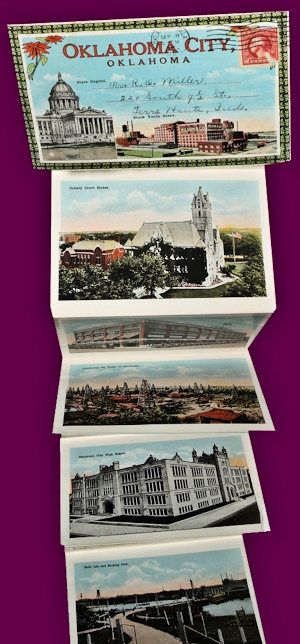 The New York S.H. Kress & Co. was an early-day 5¢-10¢-25¢ retailer with stores throughout the country. After announcing plans to establish itself here in July 1904, Kress opened shop at 217 W. Main on December 2, 1904. Soon, Kress expanded to include the 1st floor of the Illinois Hotel at 219 W. Main, as well. A 1911 Daily Oklahoman article reported that Kress had stores located in 140 cities in the United States. After acquiring long-term leases of properties on the south side of Main Street, in February 1913 Kress announced plans to build a 5-story building across the street (south) of that location and in 1914 its existing properties were leased to Sidney L. Brock of Brock's Dry Goods, forerunner of John A. Brown's department store. Although the fact did not meet the promise (the new building was 3-story, not 5, as shown in this 1950s photo), S.H. Kress relocated its downtown store to 218 W. Main in 1915 where it remained until Urban Renewal demolished it in the 1970s. ( This 1940s photo shows the area but doesn't show Kress very well). More to the point of this article, though, S.H. Kress was not only a retailer, it was a prolific producer of postcards around the country, including Oklahoma City. If you are a postcard aficionado, many of the early-day Oklahoma City postcards you've seen or own were produced by S.H. Kress & Co. The postcards shown in this article featuring Oklahoma City were produced by Kress in 1919 or 1920. Most often, Kress postcards were single cards but others were multiple-card fold-out sets with pictures on both sides, like this one. This particular fold-out set was sent by (Mr.?) H.L. Miller of Oklahoma City to Mr. R.O. Miller of Terre Haute, Indiana, on September 8, 1920, the postmark bearing "Oklahoma, Oklahoma," which is to say, before the US Postal Service accepted Oklahoma City as the name of this town. Although the 2¢ stamp presumably accomplished its purpose, at some point along its meandering path the mailing found its way to the Abalache Book Shop, 2225A Exchange Avenue, Oklahoma City, until the date that I purchased it, February 12, 2010. I'll tell a story associated with the postcards by going back in time to September 20, 1920, or, at least, try to. In the story and post card notes, I'm guessing that H.L. Miller was the son who lived in Oklahoma City and that the Terre Haute addressee, R.O. Miller, was his dad though he could easily have been a brother or other family member. Other than the literal addressor and addressee names (H.L. Miller and R.O. Miller, respectively), the story and other name attributions below, are wholly fictional.
Skip the Story & Go To the Cards
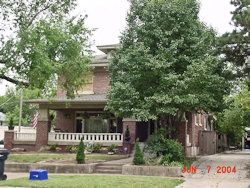 Your Day Begins. You are H.L. Miller, the proud owner of the fine home located in the area now called Mesta Park at 900 West 18th Street, Oklahoma City, built only three years earlier, but your dad, still living in Terre Haute, has never come to Oklahoma City for a visit. The date is Monday, September 20, 1920, and you just got out of bed at 5:30 a.m. to give yourself some time alone with your wife before the children get up to get ready for school. "Good morning, Charlotte," you say as you give her a kiss on the cheek, "I'll see if the paper is here yet." Your Day Begins. You are H.L. Miller, the proud owner of the fine home located in the area now called Mesta Park at 900 West 18th Street, Oklahoma City, built only three years earlier, but your dad, still living in Terre Haute, has never come to Oklahoma City for a visit. The date is Monday, September 20, 1920, and you just got out of bed at 5:30 a.m. to give yourself some time alone with your wife before the children get up to get ready for school. "Good morning, Charlotte," you say as you give her a kiss on the cheek, "I'll see if the paper is here yet."
She starts brewing the coffee and you put on your robe and go out on the front porch to see if your Daily Oklahoman newspaper has arrived yet. "Drat," you say to yourself, "late again." "Charlotte," you say upon entering the kitchen, "remind me to call Mr. Gaylord about delivery service. He hasn't got the only paper in town, you know, now has he! By 5:35, the paper should be right by the front door." "Yes, dear," she replies, adding, "Have a seat — the coffee is almost ready." Thump — you hear the paper hit your front door. "I'll be right back," you say.
 Perusing the front page, you grumble to Charlotte, "Only ten pages today — must not be much news." "The dratted socialists are trying to get seats in the New York Legislature and the Russians are trying to infiltrate Mexico," you report to Charlotte as she starts work on the children's breakfast. "Hey," you say, "I see that Tennessee men are fighting the suffrage amendment. What do you think about that, my dear?" "They're assholes," she thinks to herself (women didn't openly use such words in those days) and she merely says to you, "Oh, they'll come around, just like you have, Harland. You know, I remember a time that you felt the same way." "Hrumph," you mutter. Perusing the front page, you grumble to Charlotte, "Only ten pages today — must not be much news." "The dratted socialists are trying to get seats in the New York Legislature and the Russians are trying to infiltrate Mexico," you report to Charlotte as she starts work on the children's breakfast. "Hey," you say, "I see that Tennessee men are fighting the suffrage amendment. What do you think about that, my dear?" "They're assholes," she thinks to herself (women didn't openly use such words in those days) and she merely says to you, "Oh, they'll come around, just like you have, Harland. You know, I remember a time that you felt the same way." "Hrumph," you mutter.
On page two, you note that Tom Mix is playing in a movie at the Dreamland, thinking that might be good to see. You flip by page 3, page 4, and page 5 to get the sports page to see if the Oklahoma City Indians won their season-ending double-header yesterday with Des Moines. "Hey, we took both games," you exclaimed, but added, "Tulsa won the pennant yesterday, though. But we had a heck of a year, winding up in third place behind Tulsa and Wichita." You added, "I still chuckle at Omaha naming their team the Omahogs!" Charlotte agrees and chuckles with you.
Page 7, page 8 and page 9 don't catch your fancy but you see on page 10 that the Lincoln Memorial in Washington D.C. is nearing completion. "A waste of public money," you say to Charlotte who says, "Yes, dear."
Time passes ... the kids eat and get off to school and you get ready to catch the trolley which passes by your front door and gets you to work. You catch a quick lunch at the Kress store at 218 W. Main and, at the register, you notice a postcard folio which catches your eye. "You know," you say to the cashier, "I haven't talked with Dad for awhile ... let me have this postcard folio, if you don't mind." "Not at all, sir, that will be 5¢." You slap on a 2¢ stamp and address it to your dad who lives in Terre Haute but has never been to Oklahoma City ... 220 South 9½ Street, Terre Haute, Indiana, you write.
Before sending, you had a look over the cards and you were tempted to write the following notes on the cards to your dad hoping to lure him here for at least a visit if not to live ... you didn't since that would have messed up the cards. (You also anticipated that readers 90 years later would like to be able to click on any card without your notes for a 1500 px wide view.)
The Front Cover — State Capitol and Wilson & Co.
We don't have a capitol dome yet but you're sure we will, some day.

Card 1: The City From An Aeroplane
My, we are growing — up to 91,295 now!
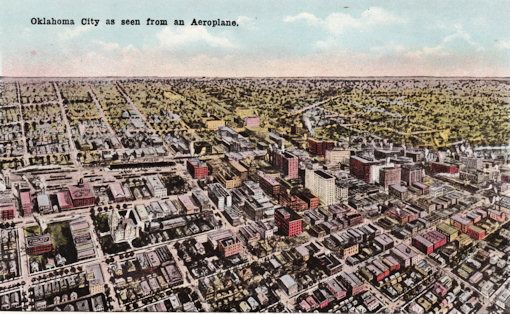

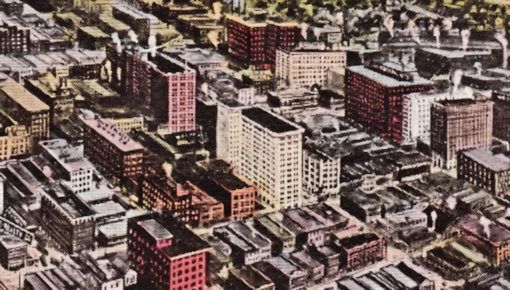
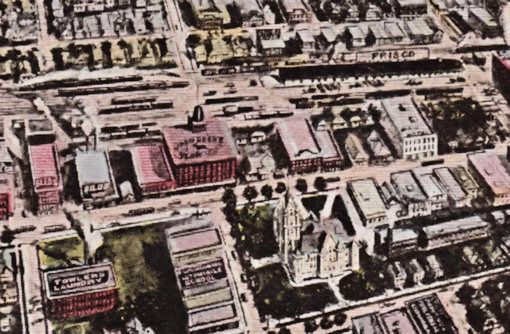
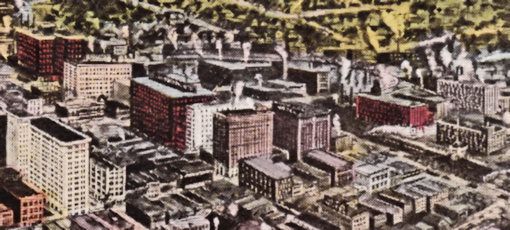
Card 2: County Courthouse
The jail is at the left.
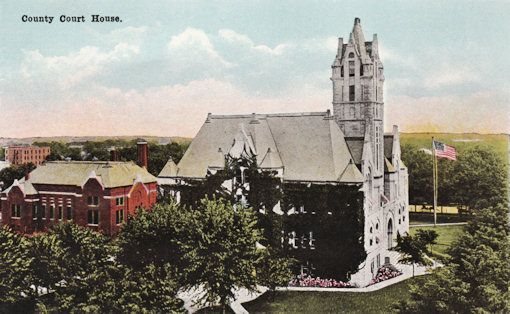
Card 3: Ford Assembling Plant
We even make our own Model T's.
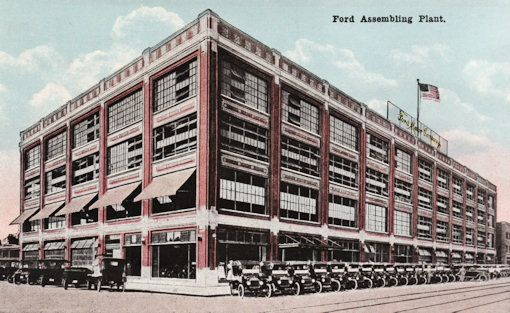
Card 4: Oil Wells
Don't ya wish we had one of these, Dad?

Card 5: Lee-Huckins Hotel
Huckins Annex, Campbell, Wells Fargo & Herskowitz buildings are at the right.
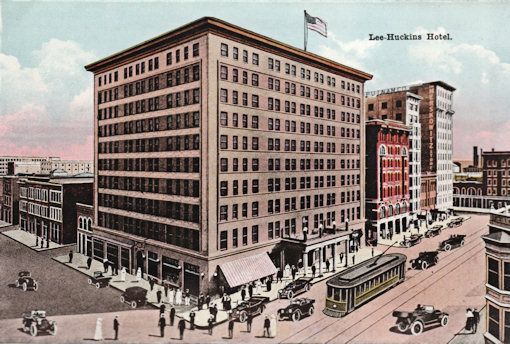
Card 6: Oklahoma City High School
We're too big for just one high school but more are coming soon.
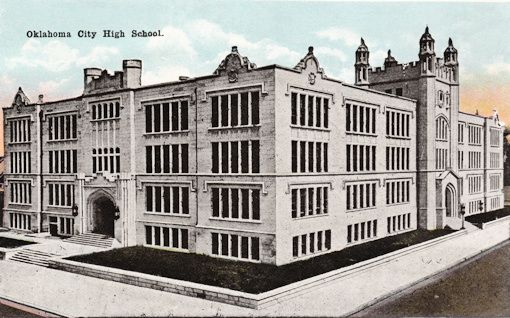
Card 7: Broadway & Grand
Left to Right: Huckins & Huckins Annex hotel buildings,
the Campbell, Wells Fargo, Herskowitz buildings, & the Kingkade Hotel.
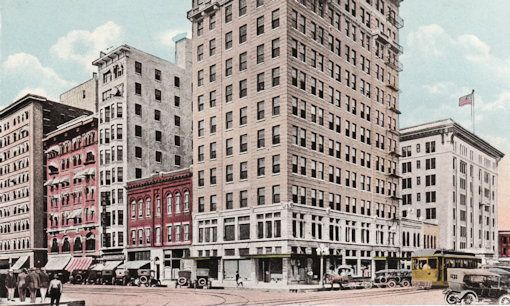
Card 8: Belle Isle Park
This is our city's finest recreational park today.
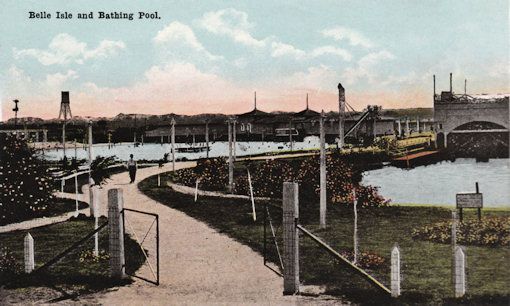
Card 9: OIL
The note at the left reads: "Oklahoma in 1915 produced 117,910,410 barrels crude oil leading all other states." The note at right reads: "Over two hundred million dollars was divided in 1915 among the workers in Oklahoma oil fields and thousands of stock-holders in Oklahoma oil companies."
The 1917 drawing is © by JP Hathaway.

Card 10: Our YMCA
The sign over the left entrance reads, "Boys," and, the right, "Men."
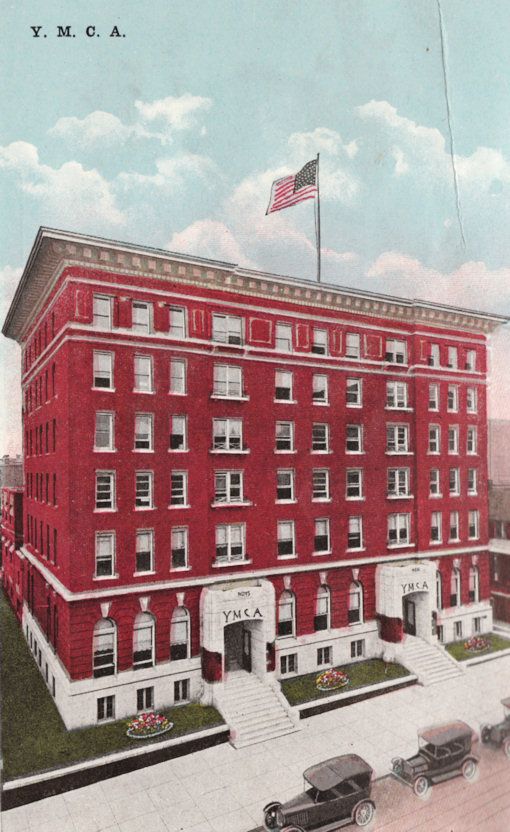
Card 11: Colcord Office Building
This is the city's most beautiful skyscraper, today.
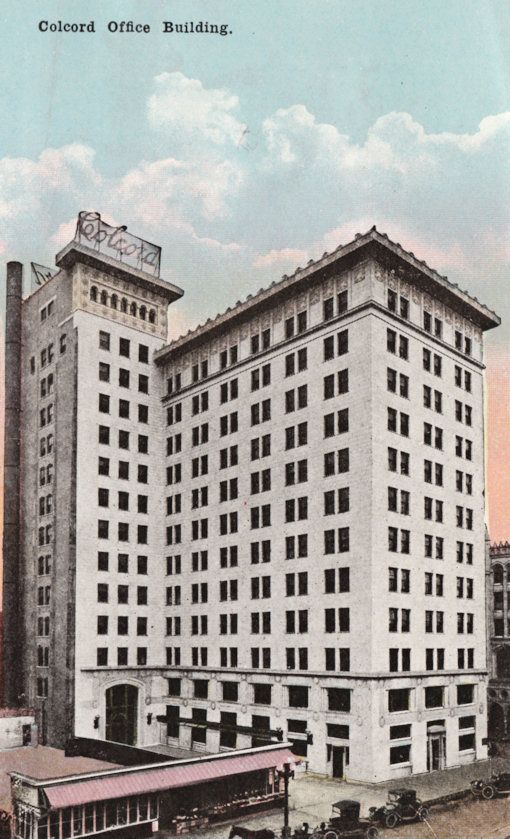
Card 12: Other Skyscrapers
Left to right are the Hales, Lee, and American National Bank buildings. In the background, you can see the Skirvin Hotel, center-right, Insurance Building, and, at the left, the Lee-Huckins Hotel.

Card 13: State FairDad, we've got a great state fair here and it is set to open this Saturday. This year, it's going to feature a special fireworks display based upon the Naval Siege of the Dardanelles a few years ago when Winston Churchill gave the order to the British navy to blast open the Turkish straits to enable the allies to attack Austria from the rear. And there will be auto races, too. Sure wish that you could be here to see them with me!
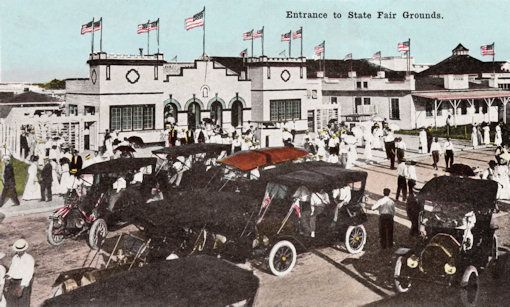
Card 14: Carnegie Library
This is our city's beautiful library.
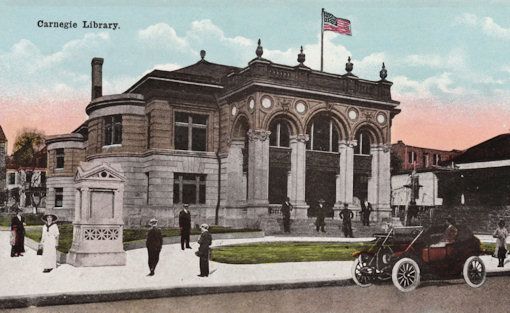
Card 15: Comanche Indians
Their original home was Texas. Those who survived the Texas Rangers (not that many)
were forced to relocate to their home today in southwest Oklahoma, near Lawton.
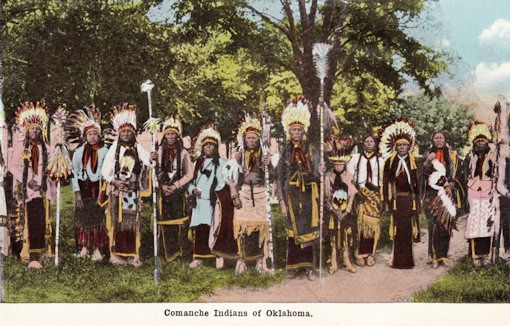
Card 16: Skirvin Hotel
The Skirvin and the Lee-Huckins are our finest hotels, but, personally, I like the Skirvin.

Card 17: Picking Cotton
Oil is important but so is cotton.
Our city is a leader in cotton exports to all over the world.
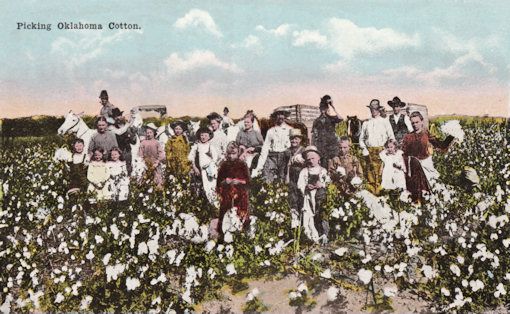
Card 18: W. T. Hale's Residence
This home is at 1521 N. Hudson, less than a mile from my house, Dad.
He owns the Hales Building, shown in card 12, above.
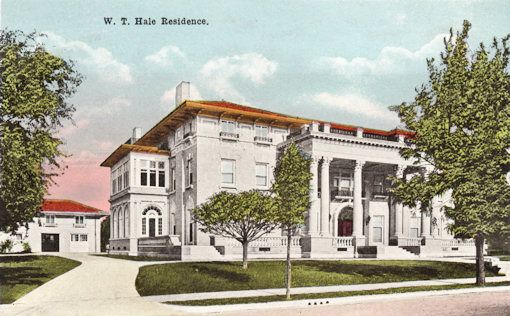
Back Cover — Santa Fe Station
I've made a mental note to find the best route from Terre Haute, Dad.
I hope that you'll come for a visit very very soon.

Go To Top
... Click here to read the full article and any comments ...
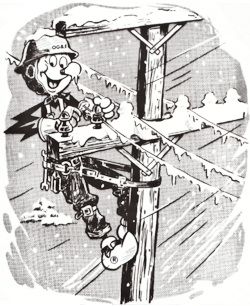 Remember that funny looking guy over there on top of that electricity pole? Remember that funny looking guy over there on top of that electricity pole? Sure you do ... that's Reddy Kilowatt, Oklahoma Gas & Electric Company's mascot for half a century — doubtless he's smiling since he didn't have to deal with the city's horrific ice storms during the past couple of years! I'll talk about his forced retirement at the end of this article. Although this article does present some of OG&E's history in the city, the content really doesn't develop the company's history in detail. Instead, the article presents looks at the city that you and I would have had were we OG&E employees, groupies or something along those lines from OG&E's birth in 1902 (actually, a bit earlier than that) through its first half-century or so but with a bit of overlap into the modern era. The primary source for this article is the book, OGE Energy Corp. — Our First 100 Years — 1902-2002 by Robert R. Morris (Donning Company 2002) which provides some absolutely stunning historical photographs of the city during that period of time. Some of those photos are probably not available to be seen from any other source than here unless you also own the out-of-print book.
First Things Before OG&E Early OG&E History
Expansion to Broadway The Harrah Plant
Middle Years — 1927-1958 No More Gas Relocation To Harvey
Belle Isle Middle Years Photos 1958 Expansion - Today
Reddy Kilowatt & Closing Notes
First Things. Before I get to the point of this article, I'll comment a bit about how I came by its primary source, the book named above. Yesterday, February 12, 2010, I had occasion to follow my nose after venturing downtown on business and the short story is that I wound up driving down Exchange toward Stockyards City looking for a place to eat. Before I got to Agnew, I recalled seeing a sign several weeks ago along that route on the north side of Exchange which read, "Abalache" something. I shelved that tidbit into a mental compartment somewhere but remembered it yesterday as I approached the Stockyards area. "Might that name mean what I thought it might," I wondered to myself? Yesterday, I learned that it did.
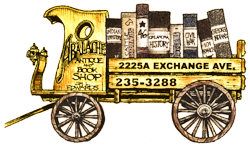
At Right: Hal Ottaway & Jim Edwards
from Vanished Splendor (I)
(Abalache Book Shop Publishing Co. 1982) | 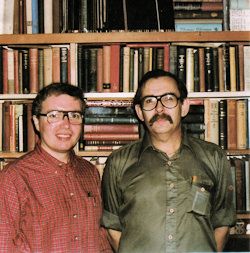 |
I almost drove past the place — it is hard to see even if you are looking for it, as I was. But, just before reaching Agnew, there it was, north of Langstons. I parked and entered the shop. An elderly and somewhat scruffy gentleman behind the counter gave a somewhat perfunctory greeting — not hostile, not friendly, just brief and to the point and with neither a warm nor welcoming smile — a beginner's tip might be not to walk into the shop expecting a hug. I introduced myself upon entering and he did the same, and it was then that I knew that I was speaking to none other than Jim L. Edwards, co-author of the marvelous Vanished Splendor 3-volume series which absolutely every Oklahoma City history lover either has or wants to have for his/her own personal library. The above photo shows Mr. Edwards 28 years ago when the initial Vanished Splendor volume was published.I should add this to immediately dispel any notion that he was being rude or unwelcoming which he was not. During the hour or so that I spent in the shop I came to learn that Edwards is a no-nonsense guy, gets right to the point, and has a very dry sense of humor that wouldn't likely be known or perceived on a first impression. As the hour or so took its course, my studied opinion of him came to be that he was, and is, quite pleasant, interesting, and, to be sure, that he is a devotee and treasure trove of Oklahoma City history. He would have to catch himself, however, when a couple of phone callers didn't pick up on his manner, dry humor and straightforward speech — to his credit after recognizing that fact, he assured the callers that what they may have perceived as dismissive or impolite remarks were not to be taken seriously and that he intended no ill will in the manner of his speech.
I hope to revisit Mr. Edwards, do an interview and whatever else might follow on a later occasion, but this is enough to say for now. Looking over everything that I could find that I didn't already have and stuff about Oklahoma City history that he had but I didn't, I selected a few purchases.
 Almost as an afterthought, one was an inexpensive book, that being the OG&E book which is the principal source for this article. I noticed that it was cheap (got it for about $4-$5) and it contained some nice photos of vintage Oklahoma City I'd not seen before. Even though I'm not big on buying books written to serve corporate remembrances, as this one was, at the price and having had a glance at a few of its photos it was impossible not to walk out the door without it. Almost as an afterthought, one was an inexpensive book, that being the OG&E book which is the principal source for this article. I noticed that it was cheap (got it for about $4-$5) and it contained some nice photos of vintage Oklahoma City I'd not seen before. Even though I'm not big on buying books written to serve corporate remembrances, as this one was, at the price and having had a glance at a few of its photos it was impossible not to walk out the door without it.
On looking at the book more closely last night, I quickly saw that I more than easily got the better of the bargain in the transaction. The scans I made of book images shown below will show why I reached that conclusion and I think that you will agree. For each image below, click the image for a larger image, typically 1024 px wide.
BEFORE OG&E. As suggested above, the book actually begins before OG&E's birth in 1902 — it begins with the day that the city came to exist, April 22, 1889.
The Land Run. Have a look at the magnificent photo below showing land runners on and off the Santa Fe train, near where the Santa Fe depot is today.
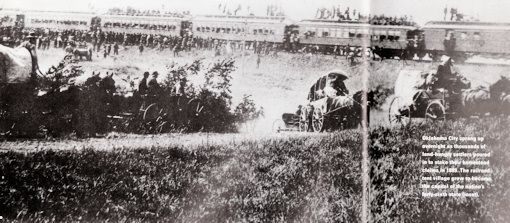
My suspicion is that the above photograph is a composite, not originally just one but two or three photographs which have been blended and pieced together to portray the different kinds of traffic which occurred on that day — buggies, train arrivals and covered wagons — merely to capture the day's essence but I have no evidence of that. Regardless, the powerfulness of the day's events are captured in the above image, be it doctored or not.
Shortly After The Land Run
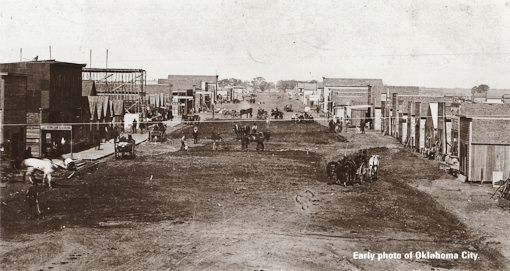
Pretty Little Surrey With The Fringe On The Top

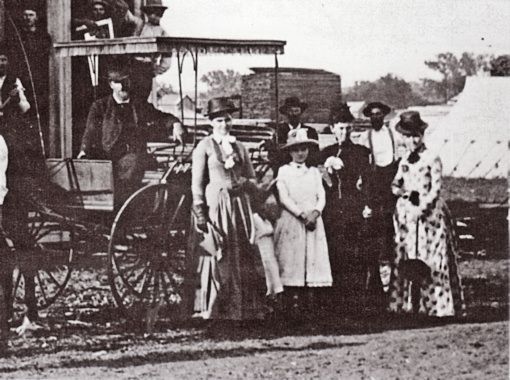
The Failed Canal. The story of the 1889 canal which was intended to produce and provide electricity to the city is told here. A pair of images in the book show canal construction and its associated power plant.
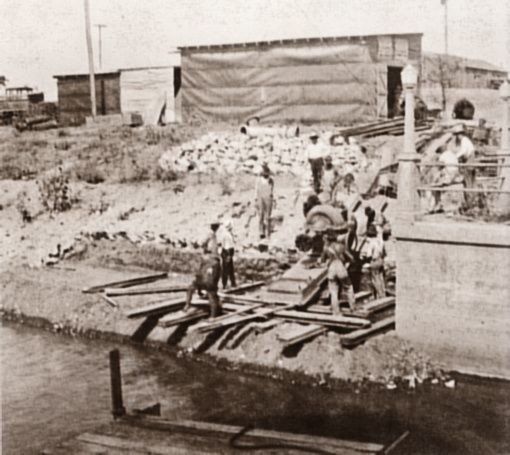
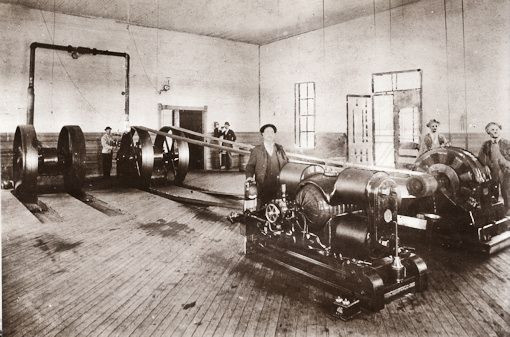
Looking North On Broadway in 1892
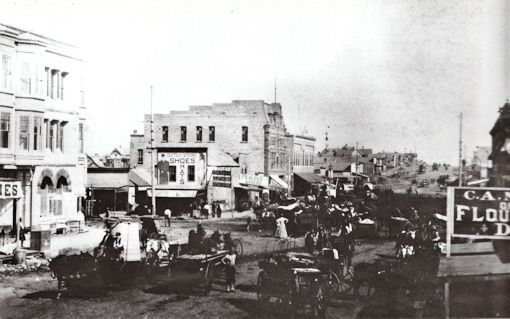
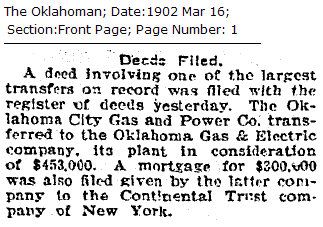 THE EARLY YEARS — 1902 THROUGH 1927. According to the book, the present day OGE Energy Corporation (but which most still call Oklahoma Gas & Electric Company, OG&E) has its start date in 1902. The Daily Oklahoman item shown at right shows that the company purchased the plant of Oklahoma City Gas and Power Co. in March 1902. The book does not identify the location of that plant but says, at page 160, THE EARLY YEARS — 1902 THROUGH 1927. According to the book, the present day OGE Energy Corporation (but which most still call Oklahoma Gas & Electric Company, OG&E) has its start date in 1902. The Daily Oklahoman item shown at right shows that the company purchased the plant of Oklahoma City Gas and Power Co. in March 1902. The book does not identify the location of that plant but says, at page 160,1902 ● Robinson and Frisco Streets. The original power plant predated incorporation. It was the one and only power facility that used coal to generate as much as seven hundred kilowatts for street lighting and home use. Although I'm making no attempt in this article to make a serious study of OG&E's history, I did want to see where that Robinson & Frisco (SW 5) location was and the most reliable resources I have for that are the Sanborn Maps available via the Oklahoma City Metropolitan Library System. Having a look, I found no energy-related entries in the maps which were located at or near Robinson & Frisco in any of the the 1898, 1901 or 1904 Sanborn Maps (and recognizing that an earlier-than-1902 organization by the same name is not claimed as part of the present organization's lineage). The book's author may not have gotten it wrong, but a basis exists to cause further study before assuming that he got it right.
At page 160, the author appears to mark 1909 as OG&E's new plant's date but that is not correct. The plant was located between Noble (SW 2nd) and Chickasaw (SW 3rd) Avenues east of Broadway and wast of the Santa Fe tracks, and used a Noble Avenue address. However, as noted above, 1898, 1902 and 1904 Sanborn maps already show that location for OG&E, showing a major expansion in the 1904 map. As a benchmark, note that the Cotton Compress was due east of the Noble Avenue location, across the Santa Fe railroad tracks.
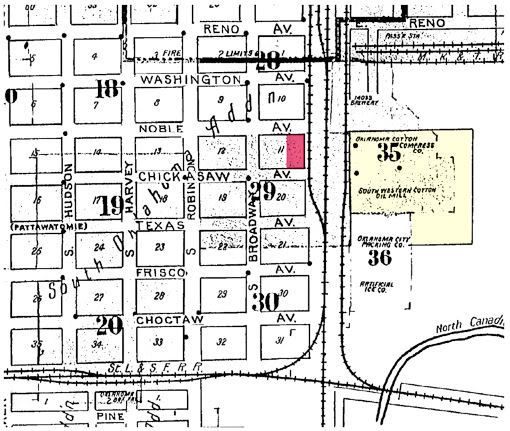
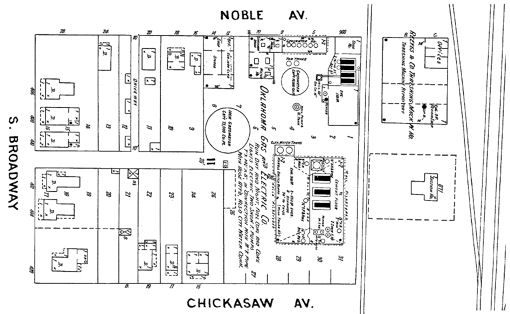
At pages 20-21 the author describes the early, and financially shaky, years of OG&E's existence. Authorized by City Council to provide electricity and gas to the city, the city also granted a natural gas franchise to People's Gas Company (one incorporator of which was Oscar G. Lee) in April 1902 and according to a brief note in the November 3, 1904, Oklahoman it was "rapidly laying its lines in all parts of the city." Litigation by OG&E against that company began in August 1902 but apparently did not ultimately succeed. By April 1905, OG&E purchased its competitor's plant and franchise.
The author traces a few other woes of the early period. One mentioned a notice placed in the October 25, 1902, Daily Oklahoman:The Oklahoma Gas and Electric Company desires to notify its customers in the resident portion of the city that owing to the heaving load on Saturday nights, it will be necessary to cut out the resident portion of the city from lighting time until ten o'clock. This will have to be done from now on until our new Electric Plant is completed, which we hope to have in operation by November 15, 1902. The author notes that by the end of the year, the situation had not changed.
A more tragic event resulted in the death of a customer. On the evening of January 27, 1903, strong winds blew down an electric service wire. Even though the company engineer was notified, he failed to turn off the power. The next morning, an unsuspecting gentleman went out to retrieve his morning paper, stepped on the live wire, and was killed.
I won't further trace the early ills or the path that was finally taken to cause OG&E to achieve stability and remarkable growth to El Reno, Enid, Muskogee, Ft. Smith, and elsewhere but will simply conclude this early period by saying that the company has a most interesting story to tell and that the author does the telling quite well. The remainder of this part is shown by many of the photos presented during this period.
The photos below show OG&E's first location and early day motor vehicles.
The book's text reads, "First service trucks featured a chain drive, solid rubber tires, a tiller for steering, and an unobstructed forward view."
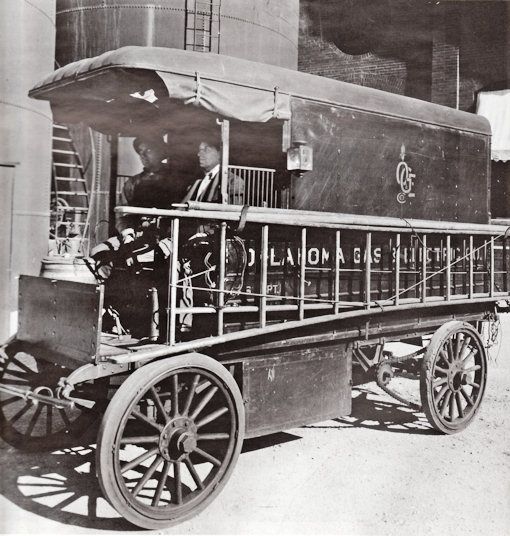
 Expansion to Broadway. The company opened its business office at 110 N. Broadway by 1905 at which location it showed its customers the latest gas and electric appliances, some shown below. The 8 story Insurance Building opened in 1910 and in 1911 OG&E became the main tenant in that building, occupying several floors and its distinctive signage marked the location. At right, three company men stand by the Broadway storefront in 1908. Expansion to Broadway. The company opened its business office at 110 N. Broadway by 1905 at which location it showed its customers the latest gas and electric appliances, some shown below. The 8 story Insurance Building opened in 1910 and in 1911 OG&E became the main tenant in that building, occupying several floors and its distinctive signage marked the location. At right, three company men stand by the Broadway storefront in 1908.
The respective locations are shown in the 1906 and 1922 Sanborn maps below.
Here by 1905
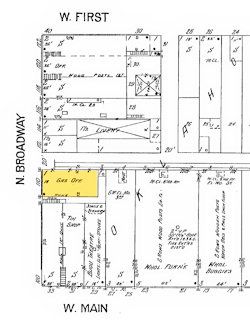 | Here in 1911
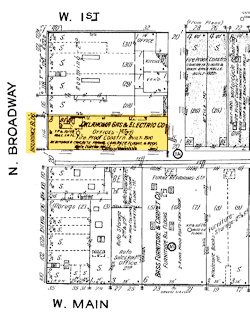 | | Recalling that OG&E also sold natural gas at the time, notice the very interesting assortment of tempting products in the 1905 showroom: |  | 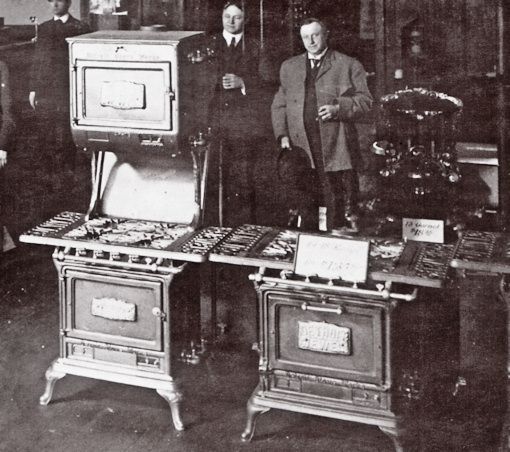 | 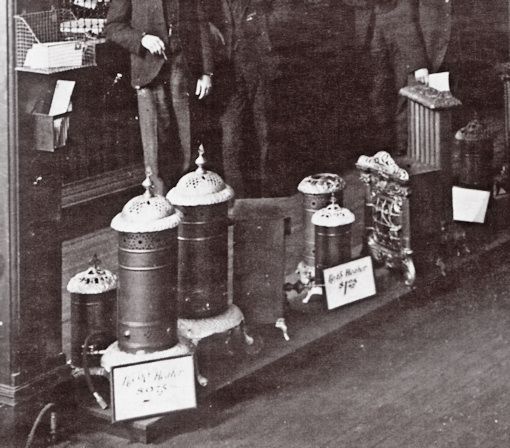 | Inside The Boiler Room
On Noble Avenue
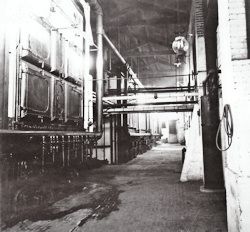 | Raising Concrete Utility Pole in 1910
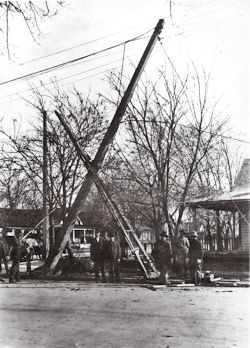 | Oil In Early 1900s
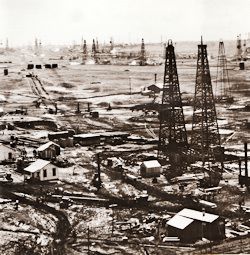 | Main Street In 1912
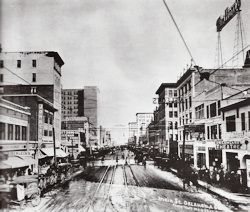 | 1909 Residential Area
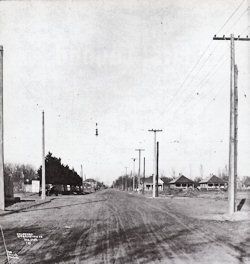 | OG&E Engineer In Touring Car
 | Early 1900s Electricity & Phone Lines
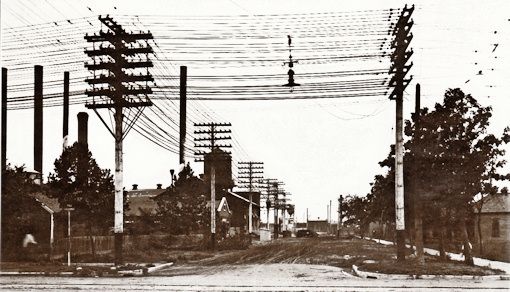 | 1911 Home In The Insurance Building
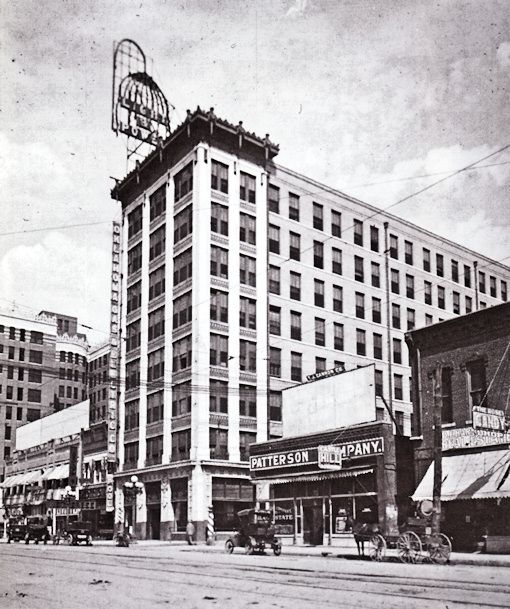 | Meter Man & Model T
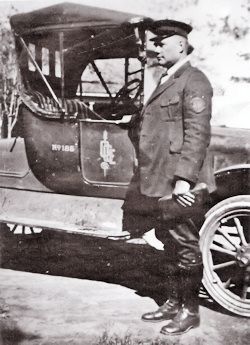 | Customer Service
Telephone Ladies
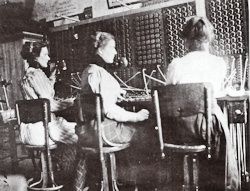 | Employees In Model T
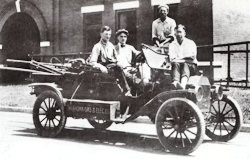 | War Effort in Muskogee
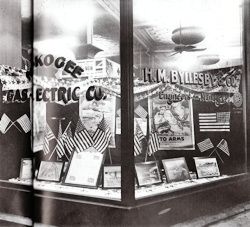 | Head Cashier In 1919
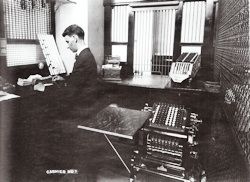 | 1919 Office In Insurance Building
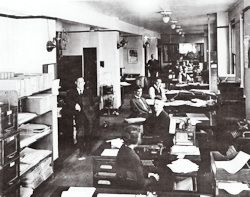 | Early 1920s Parade Float
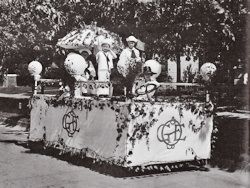 | 1923 Electric Show At
Kiefer High School (near Sapulpa)
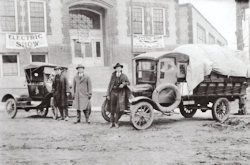 | 1921 Vehicle Fleet By Noble Avenue Plant
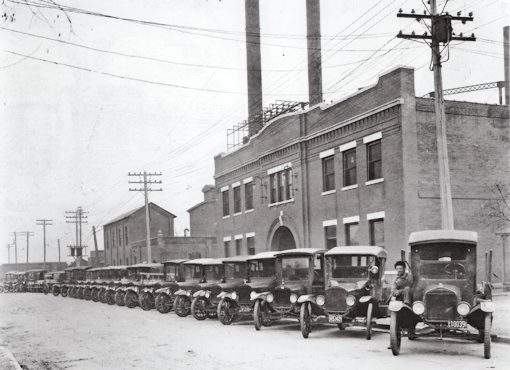 | 1925 Emergency Car
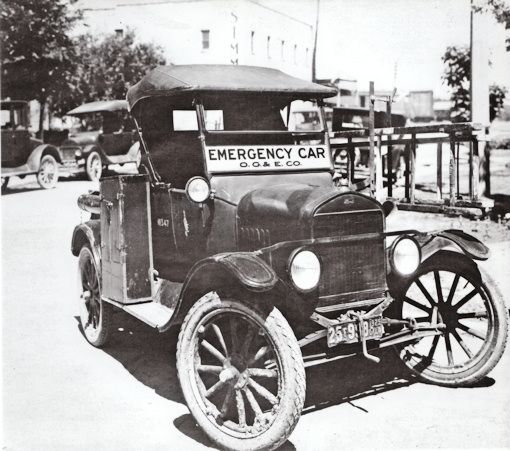 |
New Plant Near Harrah. In 1923, construction began at a new power plant sitting inside Horseshoe Lake just north of Harrah in eastern Oklahoma County. Construction was complete in 1924. A pair of 1963 images are also shown in the book.
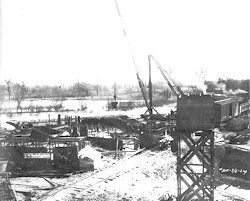 | 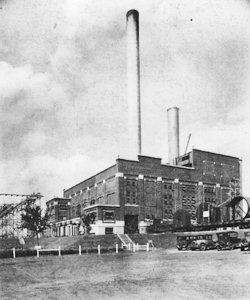 | 1963
 | 1963
Inside The Horseshoe Plant
 |
THE MIDDLE YEARS — 1927-1958. OG&E joined the onslaught of 1920s new downtown construction by adding its own new fixture to the city's skyline, even if initially it was a modest six-stories high. But, the biggest news was that OG&E effectively dropped "gas" from its offering even though retaining the name in its title.
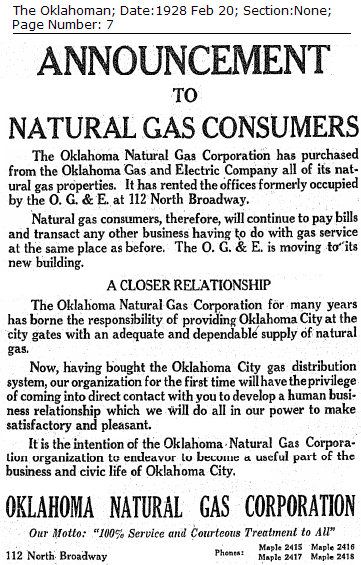 No More Gas. The book gives very little description of the decision except to say that, "Finally in 1928,OG&E made a bold and strategic move by selling all its gas properties in order to focus solely on electric power production and delivery." No More Gas. The book gives very little description of the decision except to say that, "Finally in 1928,OG&E made a bold and strategic move by selling all its gas properties in order to focus solely on electric power production and delivery."
A search of the Oklahoman's articles does reflect what became of the gas — it was acquired by Oklahoma Natural Gas, per the February 20, 1928, article at the right. As you can see from the article, ONG initially rented some of the space OG&E used in the Insurance Building but in 1931 became OG&E's neighbor when it leased space in the 5-story Key Building (formerly the Elks Lodge) which ONG purchased outright in June 1947.
Relocation To NW 3rd & Harvey. In 1927, the company announced that it would construct a new building on one of the highest points in downtown Oklahoma City, Northwest 3rd & Harvey. Although it would initially only be a six-story structure, the building was constructed so that it could double in size (which it would do about 30 years later). An excellent 1927 architectural drawing of the new building, showing its potential, is at page 48 of the book and appears below.
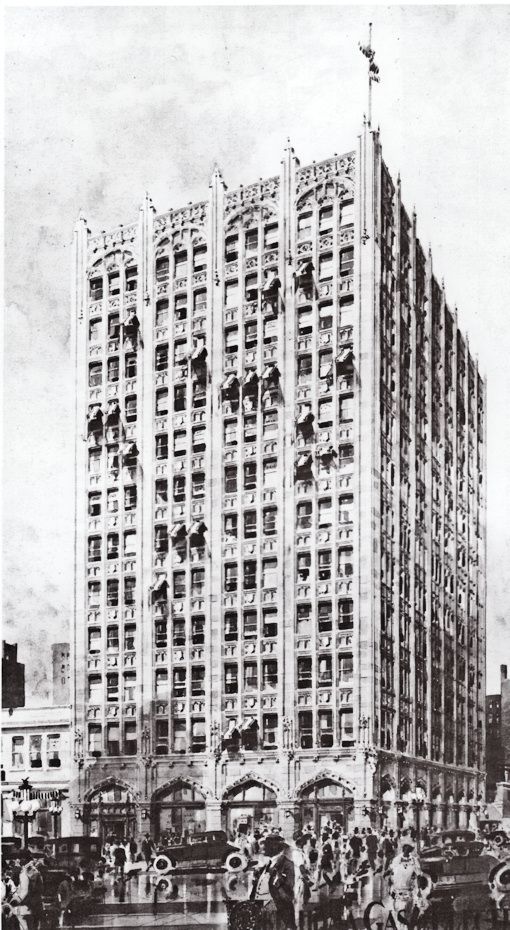
Crop Focusing On Detail

Construction which began in 1927 is shown in the following photo:
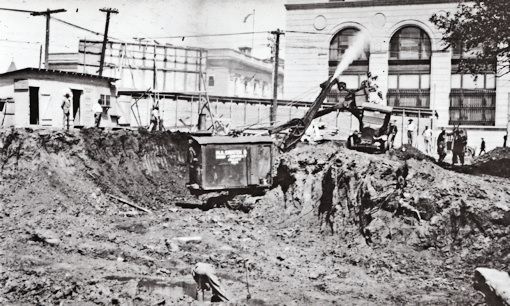
A daytime photo of the new building which had its formal opening on March 18, 1928, is contained in an Oklahoman article:
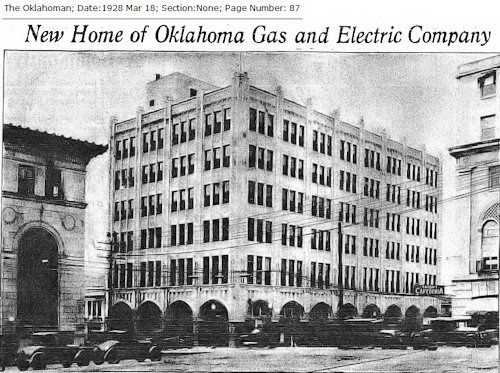  The accompanying article describes the new building's style as Gothic, finding inspiration from European Gothic cathedrals. The accompanying article describes the new building's style as Gothic, finding inspiration from European Gothic cathedrals.
Click the article's snippet, at right, for a basement to 6th floor detailed description. The article's introduction reads, "Builders of the middle ages who erected in Europe cathedrals and municipal buildings which even today are the glory of that continent, furnished the inspiration for Oklahoma City's latest office building — the new home of the Oklahoma Gas and Electric Company at Third street and Harvey avenue. ¶ The building is of Gothic architecture, modified to meed the requirements of modern commercial use. Its windows and doors on the street-level floor carry out the Gothic arch and Gothic lines in all their purity, and the main lobby and elevator lobby show the influence of long-forgotten craftsmen who labored slowly to create the architectural wonders of medieval times."
A 1928 Photo Shows OG&E's
1st Christmas At Its New Location
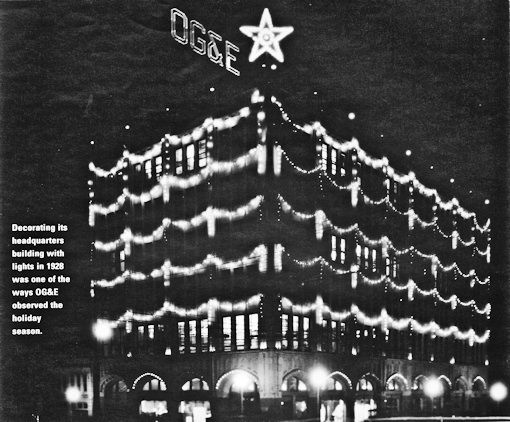
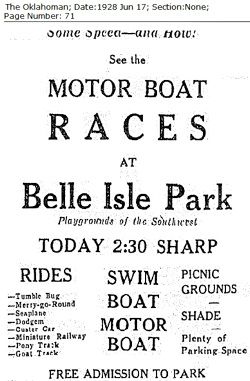 Belle Isle. In my estimation, a serious criticism and shortcoming of this otherwise fine book is the inattention that it gives to a major piece of Oklahoma City's history, as well of OG&E's, Belle Isle Park — the opportunity to showcase OG&E's connectivity with Oklahoma City and its history was, quite simply, skipped almost entirely. Almost no mention is made of OG&E's purchase of the Belle Isle generating plant from the Oklahoma Railway Company in 1928 — or, in fact, why that plant came to exist in the first place. At page 49, the author states, "The history of OG&E had a famous twist when the Belle Isle property was purchased in 1928. Although no longer functioning when purchased, the land was the site of an amusement park which flourished during the nineteen teens and twenties." That cursory statement is just about all there is in the book about the Belle Isle property. Belle Isle. In my estimation, a serious criticism and shortcoming of this otherwise fine book is the inattention that it gives to a major piece of Oklahoma City's history, as well of OG&E's, Belle Isle Park — the opportunity to showcase OG&E's connectivity with Oklahoma City and its history was, quite simply, skipped almost entirely. Almost no mention is made of OG&E's purchase of the Belle Isle generating plant from the Oklahoma Railway Company in 1928 — or, in fact, why that plant came to exist in the first place. At page 49, the author states, "The history of OG&E had a famous twist when the Belle Isle property was purchased in 1928. Although no longer functioning when purchased, the land was the site of an amusement park which flourished during the nineteen teens and twenties." That cursory statement is just about all there is in the book about the Belle Isle property.
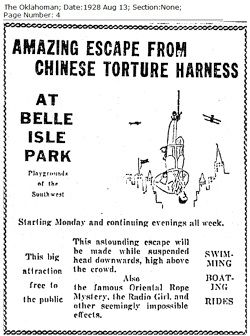 Not only is the slight an error in judgment, what was said about the park not functioning as such at the time of purchase is just plain wrong, as you can see from these two of the many Belle Isle Park ads which appeared through the end of summer 1928. Not only is the slight an error in judgment, what was said about the park not functioning as such at the time of purchase is just plain wrong, as you can see from these two of the many Belle Isle Park ads which appeared through the end of summer 1928.
Although it's true that the younger kid on the amusement park block, Springlake, had by 1928 vastly overtaken Belle Isle Park in the number of rides and popularity, Belle Isle Park's amusements were ended at or shortly after OG&E's purchase of the generating plant. OG&E's business was electricity, not amusements, and it was OG&E that shut down the amusement ride aspects of the park. Also missing is the fact that OG&E continued to maintain and make available to the public, free of charge, those aspects of the park that did not involve rides and other commercial activity.
 The Oklahoma Railway Company purchased the Belle Isle Lake property in the mid-to-late 1900s to deal with a serious problem: its trolley cars were not being supplied with sufficient electricity by OG&E during peak periods and that sometimes resulted in trolley cars and passengers being stranded mid-route. Hence, the trolley and interurban line decided to build its own generating plant at Belle Isle Lake and, while they were at it, make an exceptional recreational area that served the city until 1928, and, in non-amusement park aspects, for decades after that. The ORC plant was operational by 1909, at least. The Oklahoma Railway Company purchased the Belle Isle Lake property in the mid-to-late 1900s to deal with a serious problem: its trolley cars were not being supplied with sufficient electricity by OG&E during peak periods and that sometimes resulted in trolley cars and passengers being stranded mid-route. Hence, the trolley and interurban line decided to build its own generating plant at Belle Isle Lake and, while they were at it, make an exceptional recreational area that served the city until 1928, and, in non-amusement park aspects, for decades after that. The ORC plant was operational by 1909, at least.
At right: New plant construction is announced for Belle Isle in 1929.
Except for the closing photograph in the next series, none are from the book and all images are credited to the Oklahoma Historical Society and can be found in its Star Archives website.1909
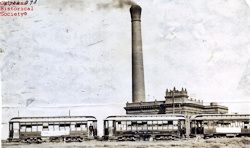 | 1910
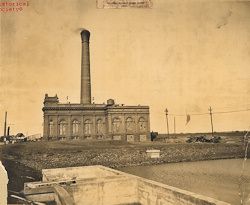 | 1915
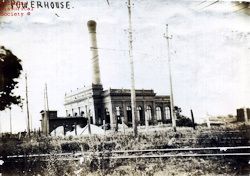 | 1929
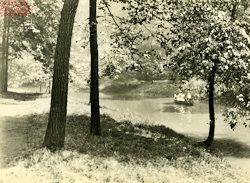 | 1930
 | 1931
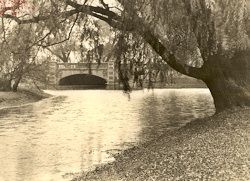 | 1941 Employee Picnic
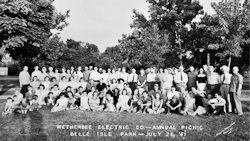 | 1944
 | 1945 Inside the Plant
 | 1945 Inside the Plant
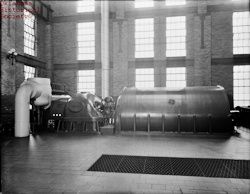 | 1951 Aerial
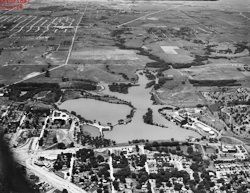 | 1951 Aerial
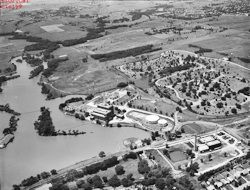 | Undated Aerial
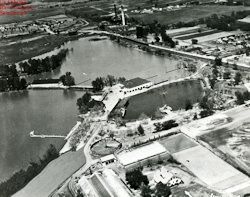 | Undated Aerial
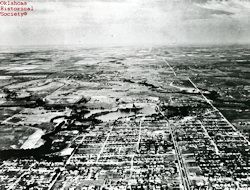 | Undated Aerial
 | Undated Aerial
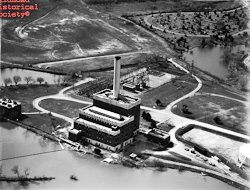 |
The book's only photo of the Belle Isle plant/park/property is at page 107:
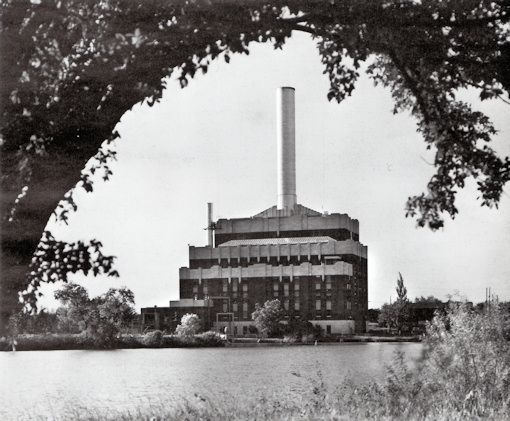
 The book's text notes that the plant had become obsolete and inoperable and that it was dismantled and destroyed after 1980. Oklahoman articles provide the missing detail. An April 23, 1980, article reported OG&E's decision to retire the plant later that year. Although proposals were made to save the building and convert it to commercial use, that didn't happen and a January 25, 1999, article reports on the Belle Isle plant's destruction by explosives. Today, a non-iconic Wal-Mart and other strip mall retail outlets occupy the once proud historic space. The book's text notes that the plant had become obsolete and inoperable and that it was dismantled and destroyed after 1980. Oklahoman articles provide the missing detail. An April 23, 1980, article reported OG&E's decision to retire the plant later that year. Although proposals were made to save the building and convert it to commercial use, that didn't happen and a January 25, 1999, article reports on the Belle Isle plant's destruction by explosives. Today, a non-iconic Wal-Mart and other strip mall retail outlets occupy the once proud historic space.
Images During the Middle Years. The book contains several excellent images associated with OG&E and the city and some others, shown below.Ice Deliveries Until 1931
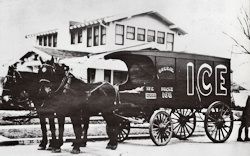 | Elevator Operators 1928
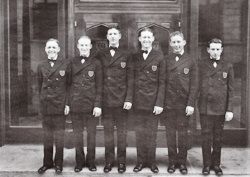 | Manhole Duty 1928
 | Cashiers On Harvey
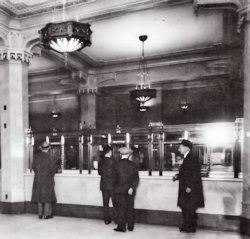 | Baseball Team 1928
 | Basketball Team 1928-29
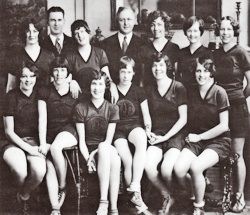 | Resuscitation Team 1928
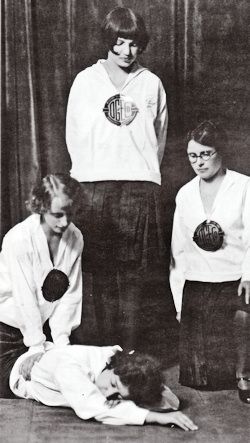 | Black Employees Picnic 1929
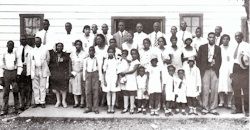
Christmas Parade Float 1931
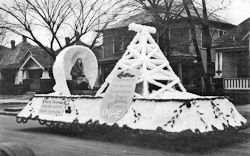 | Bethany In 1941
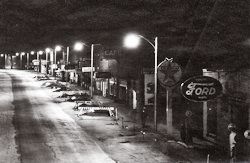 | Enid In 1938
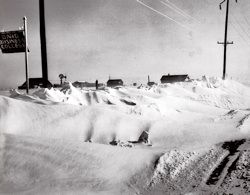 |
1958 - 2002. As noted in Relocation to NW 3rd & Harvey, above, when constructed in 1927-28 the company's office building was built with an eye to later possible expansion. Thirty years later, in 1958, the original 6-story corporate headquarters finally got its additional 6-stories and the building we know today was done. However, the author says that by 1987 the historic building was too small to house all corporate office personnel and that in 1992 OG&E leased 250,000 square feet in the new Corporate Tower building on Robinson, south of the Robinson Renaissance Building today. After remodeling its original structure and design in the mid 1990s — including the replacing of many desks and credenzas with ergonomic work stations — on October 5, 1998, the company returned to and has since remained in its historic home.
Construction In 1958
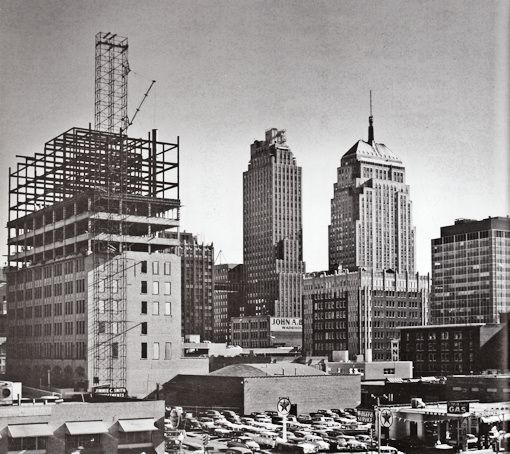
According to the book,
the signage below was removed in 1978
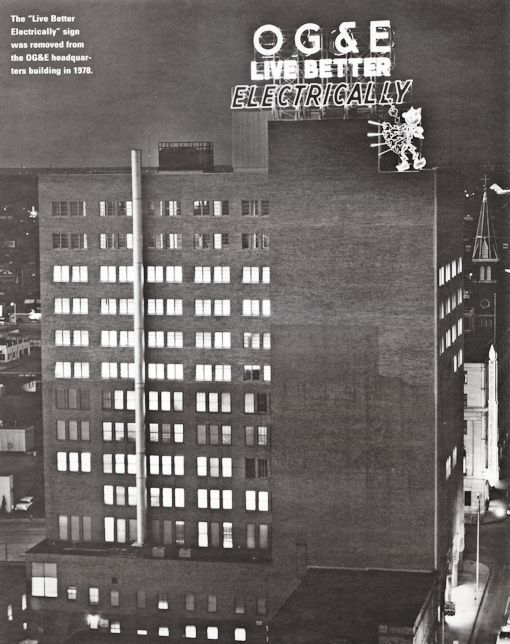
At Corporate Tower 1992 Until 1998
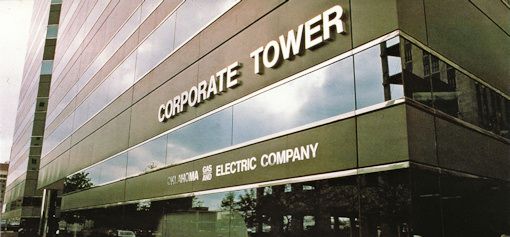
Skyline View In 2002
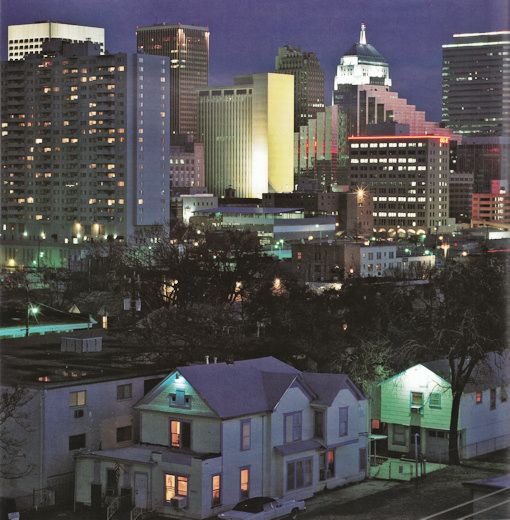
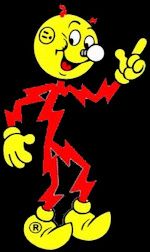  REDDY KILOWATT & CLOSING NOTES. Hey, boys & girls, do you miss me? You know that's what he's wondering, don't you? REDDY KILOWATT & CLOSING NOTES. Hey, boys & girls, do you miss me? You know that's what he's wondering, don't you?
From September 1936 until June 1994, this ubiquitous happy little guy, Reddy Kilowatt, was OG&E's face and ambassador to the public. We saw him in ads, we saw him give us helpful information, we saw him wave a flashing wand on top of the company's corporate building, we saw him climb service poles in winter weather and be happy doing so.
The photo below shows Reddy being hoisted to the top of corporate headquarters in the 1930s ...
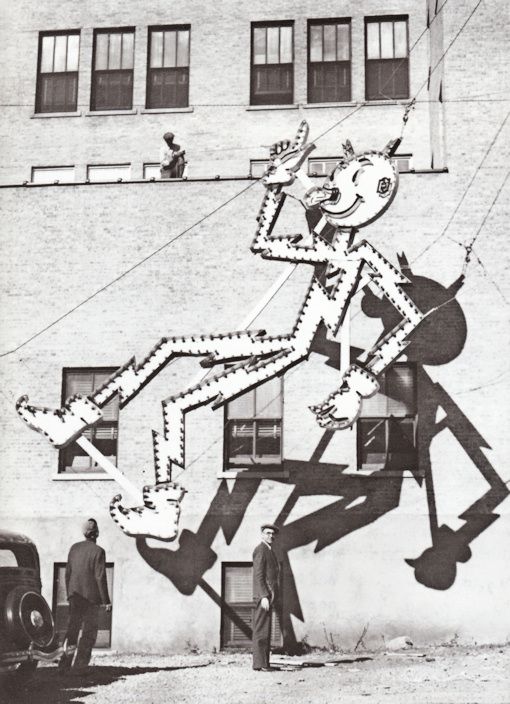
A later version of Reddy sits atop the newer building in the 1960s through 1978, waving his magic electric wand ...
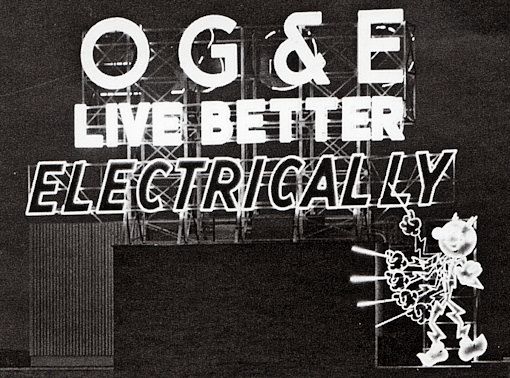 Purchasing Tips
in 1938
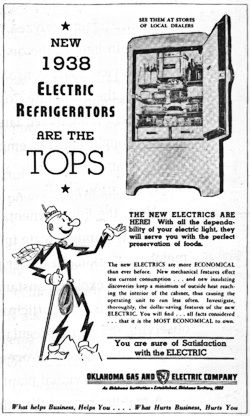 | Dust Storm Tips in 1938
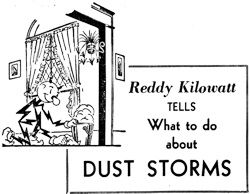
On A Pole in the 1970s
 |
The author explains that Reddy's life started in 1926 when Ashton B. Collins, merchandising manager of the Alabama Power Company, created him. Other companies around the company — more than 200 — got licenses to use him, and, if you Google for Reddy Kilowatt, you'll find him to have gained something akin to cult status. See www.reddykilowatt.org, for example. As for OG&E, the author said, "At one time, OG&E staffers would take turns playing the part of Reddy Kilowatt at various functions with a yellow full-body costume."
Today, in 2010, we in Oklahoma see Reddy no more. What happened to the little guy? The author said, "In the 1990s, times and symbols had changed so that OG&E no longer used Reddy Kilowatt as a corporate mascot."
In researching the Oklahoman's archives I found the following: The last use of Reddy in the company logo that I could find appeared in this June 26, 1994, OG&E ad. Right after that, a July 14 article announced that OG&E had decided to adopt a new logo. A few days later, on on July 29, Oklahoma Gas & Electric Company announced that it had also decided to adopt a new name, OG&E Electric Services, or, more simply for logo purposes, OG+E, including the italics.
Well, the truth is, the company has had numerous logos over its now 108 years of existence and will likely come to have others in the future. But, when OG+E takes a vote for the next change, if I'm asked to participate, I'll be doing a write-in campaign for the little guy at the left, below.
 | vs. |  |
Go To Top
... Click here to read the full article and any comments ...
|







































 THE EARLY YEARS — 1902 THROUGH 1927. According to the book, the present day OGE Energy Corporation (but which most still call Oklahoma Gas & Electric Company, OG&E) has its start date in 1902. The Daily Oklahoman item shown at right shows that the company purchased the plant of Oklahoma City Gas and Power Co. in March 1902. The book does not identify the location of that plant but says, at page 160,
THE EARLY YEARS — 1902 THROUGH 1927. According to the book, the present day OGE Energy Corporation (but which most still call Oklahoma Gas & Electric Company, OG&E) has its start date in 1902. The Daily Oklahoman item shown at right shows that the company purchased the plant of Oklahoma City Gas and Power Co. in March 1902. The book does not identify the location of that plant but says, at page 160,

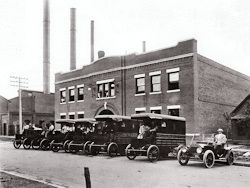
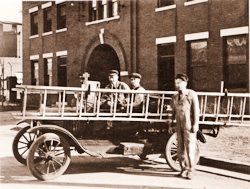





























 No More Gas. The book gives very little description of the decision except to say that, "Finally in 1928,OG&E made a bold and strategic move by selling all its gas properties in order to focus solely on electric power production and delivery."
No More Gas. The book gives very little description of the decision except to say that, "Finally in 1928,OG&E made a bold and strategic move by selling all its gas properties in order to focus solely on electric power production and delivery."







 The Oklahoma Railway Company purchased the Belle Isle Lake property in the mid-to-late 1900s to deal with a serious problem: its trolley cars were not being supplied with sufficient electricity by OG&E during peak periods and that sometimes resulted in trolley cars and passengers being stranded mid-route. Hence, the trolley and interurban line decided to build its own generating plant at Belle Isle Lake and, while they were at it, make an exceptional recreational area that served the city until 1928, and, in non-amusement park aspects, for decades after that. The ORC plant was operational by 1909, at least.
The Oklahoma Railway Company purchased the Belle Isle Lake property in the mid-to-late 1900s to deal with a serious problem: its trolley cars were not being supplied with sufficient electricity by OG&E during peak periods and that sometimes resulted in trolley cars and passengers being stranded mid-route. Hence, the trolley and interurban line decided to build its own generating plant at Belle Isle Lake and, while they were at it, make an exceptional recreational area that served the city until 1928, and, in non-amusement park aspects, for decades after that. The ORC plant was operational by 1909, at least.

































 REDDY KILOWATT & CLOSING NOTES. Hey, boys & girls, do you miss me? You know that's what he's wondering, don't you?
REDDY KILOWATT & CLOSING NOTES. Hey, boys & girls, do you miss me? You know that's what he's wondering, don't you?


















